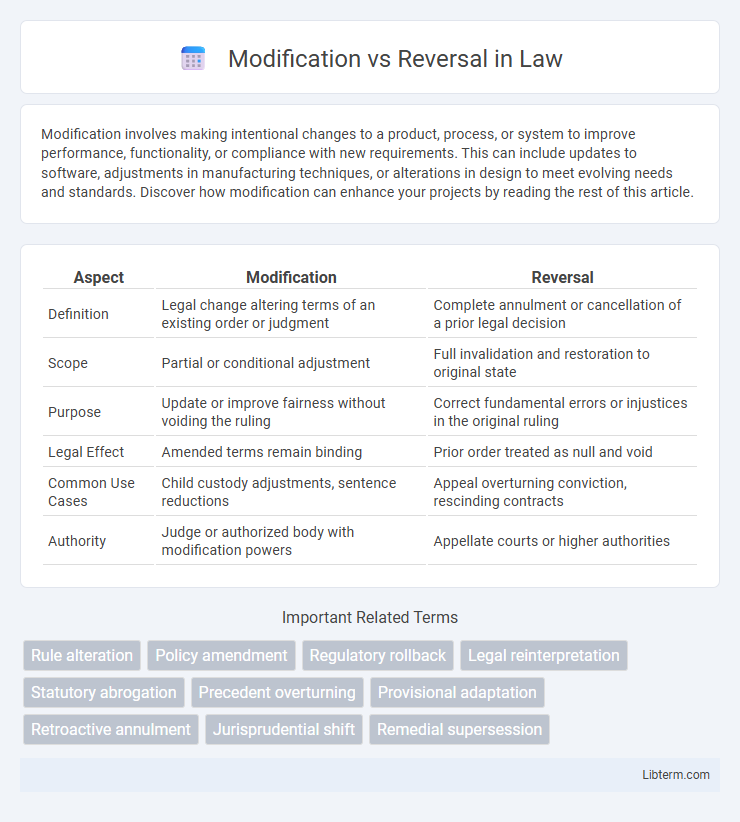Modification involves making intentional changes to a product, process, or system to improve performance, functionality, or compliance with new requirements. This can include updates to software, adjustments in manufacturing techniques, or alterations in design to meet evolving needs and standards. Discover how modification can enhance your projects by reading the rest of this article.
Table of Comparison
| Aspect | Modification | Reversal |
|---|---|---|
| Definition | Legal change altering terms of an existing order or judgment | Complete annulment or cancellation of a prior legal decision |
| Scope | Partial or conditional adjustment | Full invalidation and restoration to original state |
| Purpose | Update or improve fairness without voiding the ruling | Correct fundamental errors or injustices in the original ruling |
| Legal Effect | Amended terms remain binding | Prior order treated as null and void |
| Common Use Cases | Child custody adjustments, sentence reductions | Appeal overturning conviction, rescinding contracts |
| Authority | Judge or authorized body with modification powers | Appellate courts or higher authorities |
Understanding Modification and Reversal
Modification and reversal are two distinct legal terms referring to changes in court orders or judgments. Modification involves altering specific terms of an existing order without nullifying it, often due to changed circumstances or new evidence. Reversal, however, means completely undoing the lower court's decision, effectively restoring the parties to their original positions before the judgment.
Key Differences Between Modification and Reversal
Modification refers to altering a court's original judgment or order in part while maintaining its overall validity, often addressing specific issues such as sentencing or terms of an agreement. Reversal completely overturns the lower court's decision, nullifying its effect and typically remanding the case for new proceedings. Key differences include the scope of change--partial adjustment versus total annulment--and the impact on the case's legal standing, where modification preserves the decision in modified form, and reversal negates it entirely.
When to Choose Modification
Choose modification during an appeal when the goal is to adjust the original decision's terms without completely overturning it, often in cases involving sentencing, benefits, or contract terms. Courts typically grant modification when new evidence emerges or circumstances change significantly since the initial ruling, such as altered financial status or rehabilitation progress. Modification is preferable for achieving a tailored outcome that improves fairness while preserving the overall judgment's validity.
When Reversal is Appropriate
Reversal is appropriate when the appellate court finds a clear error in the application of law or a significant procedural mistake that affected the trial's outcome. It is also necessary when new evidence emerges that substantially alters the case facts, undermining the original judgment. Courts reserve reversal for cases where upholding the decision would result in a miscarriage of justice or violate legal standards.
Legal and Procedural Implications
Modification involves altering the terms or conditions of a legal decision or order while maintaining its original effect, often requiring a formal procedural motion and meeting specific statutory criteria. Reversal completely nullifies the prior ruling, effectively undoing it and restoring the parties to their original positions, usually resulting from an appellate court finding legal or procedural errors. Both actions impact case outcomes and procedural timelines, but modification offers flexibility within the existing framework whereas reversal demands a fundamental correction of judicial errors.
Impact on Outcomes and Stakeholders
Modification and reversal significantly influence legal outcomes and stakeholder interests by shaping case resolutions and precedents. Modifications adjust specific parts of a decision, often balancing stakeholder needs while preserving the overall judgment, potentially maintaining stability for involved parties. Reversals overturn entire decisions, leading to substantial shifts in legal interpretations and stakeholder consequences, which can result in increased uncertainty or dramatic changes in rights and responsibilities.
Common Scenarios for Modification and Reversal
Modification commonly occurs when courts adjust lower court rulings to correct errors or adapt outcomes based on new evidence, often seen in child custody cases or sentencing adjustments. Reversal is frequent in appellate cases where a higher court overturns a trial court's decision due to legal errors or misinterpretations, typically in criminal convictions or contract disputes. Both processes serve to ensure justice by refining or invalidating prior judgments to reflect accurate application of law.
Challenges in Implementing Changes
Modification and reversal of policies both encounter significant challenges in implementation, primarily due to entrenched stakeholder interests and institutional inertia. Legal complexities and procedural requirements often prolong the process, causing delays and inconsistencies in enforcement. Furthermore, changes in public perception and political dynamics complicate efforts to achieve consensus and sustain reforms.
Case Studies: Real-World Examples
Modification and reversal in legal contexts reflect different judicial responses to appellate review, with modification involving changes to certain aspects of a lower court's decision while leaving the overall judgment intact, and reversal meaning the entire decision is overturned. In landmark case studies such as United States v. Booker, the Supreme Court modified sentencing guidelines to enhance judicial discretion without nullifying the entire ruling, whereas in Brown v. Board of Education, the Court reversed the precedent established by Plessy v. Ferguson, effectively dismantling the "separate but equal" doctrine. These examples illustrate how courts balance the need for legal stability with evolving interpretations of justice through modification and reversal.
Best Practices for Decision-Making
Effective decision-making in modification versus reversal scenarios hinges on comprehensive impact analysis and stakeholder consultation to ensure alignment with business objectives. Prioritizing a structured evaluation framework allows for clear comparison of potential risks, benefits, and long-term consequences, optimizing strategic outcomes. Leveraging data-driven insights and scenario planning enhances accuracy and confidence in selecting the most advantageous course of action.
Modification Infographic

 libterm.com
libterm.com